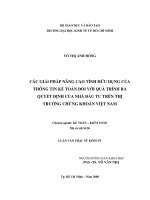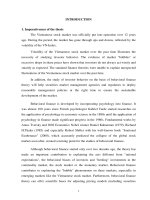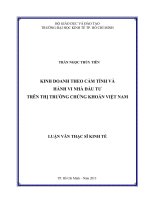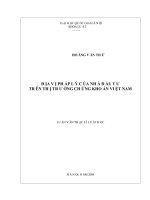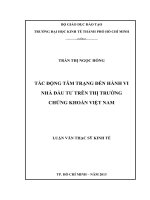tóm tắt tiếng anh hành vi của nhà đầu tư trên thị trường chứng khoán việt nam
Bạn đang xem bản rút gọn của tài liệu. Xem và tải ngay bản đầy đủ của tài liệu tại đây (212.22 KB, 28 trang )
1
INTRODUCTION
1. Imperativeness of the thesis
The Vietnamese stock market was officially put into operation over 12 years
ago. During the period, the market has gone through ups and downs, reflected by the
volatility of the VN-Index.
Volatility of the Vietnamese stock market over the past time illustrates the
necessity of studying investor behavior. The evidence of market "bubbles" or
excessive drops in share prices have shown that investors do not always act wisely and
smartly as expected. The standard finance theories were unable to explain unexpected
fluctuations of the Vietnamese stock market over the past time.
In addition, the study of investor behavior on the basis of behavioral finance
theory will help securities market management agencies and regulators to deploy
reasonable management policies at the right time to ensure the sustainable
development of the market.
Behavioral finance is developed by incorporating psychology into finance. It
was almost 100 years since French psychologist Gabriel Tarde started researches on
the application of psychology in economic science in the 1880s until the application of
psychology in finance made significant progress in the 1980s. Fundamental works by
Amos Tversky and 2002 Economics Nobel winner Daniel Kahneman (1979), Richard
H.Thaler (1985) and especially Robert Shiller with his well-known book "Irrational
Exuberance" (2000), which accurately predicted the collapse of the global stock
market soon after, created a turning point for the studies of behavioral finance.
Although behavioral finance started only over two decades ago, the theory has
made an important contribution to explaining the acts different from "rational
expectations", the behavioral biases of investors and "herding" investments in the
commodity market, the stock market or the monetary market. Behavioral finance
contributes to explaining the "bubble" phenomenon on these markets, especially in
emerging markets like the Vietnamese stock market. Furthermore, behavioral finance
theory can offer scientific bases for adjusting pricing models (including securities
2
andderivatives pricing models, etc.); for being applied in corporate governance
theories or for explaining the interaction among different markets.
2. Research Objective
The Dissertation "The investor behavior on the Vietnamese stock market"
focuses on clarifying six main issues related to the behavior of individual investors on
the Vietnamese stock market as follows:
(1) Explore and measure the determinants of individual investor behavior on the
stock market;
(2) Explore the factors that influence individual investor behavior;
(3) Clarify the impact of psychological factors on individual investor behavior;
(4) Clarify the relationship between education level and transaction scale with
investment efficiency;
(5) Clarify the availability effect and behavioral biases of individual investors on
the Vietnamese stock market; Demonstrate that individual investors on the
Vietnamese stock market are “irrational” and do not follow the prospect
theory;
(6) Explore the herd mentality on the Vietnamese stock market.
3. Object and scope of the study
The object of the study is the behavior of individual investors on the
Vietnamese stock market. The Dissertation studies individual investor behavior via
questionnaires to 500 individual investors on the Vietnamese stock market.
In addition to the questionnaire, the Dissertation uses the trading results of the
2,300 accounts of individual investors with over 100,000 orders to analyze and
examine the behavior of individual investors.
The scope of the Dissertation is limited to the behavior of individual investors.
4. Fundamental theoretical framework
Prospect Theory developed by Kahneman and Tversky (1979, 2000),an
important work that helped Kahneman win the Nobel Prize in 2002,was used as the
theoretical foundation for the Dissertation.
5. Research hypotheses
Hypothesis 1: Individualinvestors on the Vietnamese stock market are irrational
and their behavior is explained by Prospect Theory.
Hypothesis 2: Psychological components in the behavior of individual investors
3
on the Vietnamese stock market include(1) Over-optimism; (2) Herding mentality; (3)
Overconfidence; (4) Risk aversion; and (5) Pessimism.
Hypothesis 3: Education level has positive correlation with psychological
elements: optimism and confidence; while it has negative correlation with
psychological elements: pessimism, attitude towards risks and herding mentality.
Hypothesis 4: Age of investorshas positive correlation with psychological
elements: optimism and confidence; while it has negative correlation with
psychological elements: pessimism, attitude towards risks and herding mentality.
Hypothesis 5: The relationship between education level and other measures
related to investor behavior:
Hypothesis 6: The relationship between the age of investors and other measures
related to individual investor behavior:
Hypothesis 7: Male investors are usually more confident and more effective in
securities investments than female counterparts.
Hypothesis 8: Education level raises the profitability ratio, whereas average
total investment reduces the profitability ratio. Education level has larger impact on
profitability than total investments.
Hypothesis 9: Elements of fundamental analysis of securities investment (macro
analysis, industry analysis, company analysis) affect the decisions of individual
investors.
Hypothesis 10: There isempirical rule effects(heuristic) in the behavior of
individual investors
Hypothesis 11: Account distribution effectexists in the behavior of individual
investors
Hypothesis 12: Herd mentality exists in individual investor behavior
6. C
ontribution of the Dissertation
* Academic and theoretical contributions
Based on about 100 researches on behavioral finance, the Dissertation focuses on
clarifying the theoretical foundation on individual investor behavior on the stock
market according to behavioral finance approach. Academically, theoretical
contributions of the Dissertationare presentedin the following main aspects:
1. Constructing the main themes (main contents) of individual investor behavior
according to behavioral finance approach.
2. Create a link between the theory on testing individual investor behavior via
questionnaire and testing of individual investor behavior through real trading
results on investor accounts.
4
* Findings and recommendations drawn from the research results
(1) The Dissertation finds quantitative evidence to show that individual investors on
the Vietnamese stock market are irrational and have behavioral biases. Therefore,
standard finance theoriesare unable to explain the behavioral biases of investors.
TheDissertation then recommends changinga number of policies related to the
management and operation of the stock market such asspecifying price
fluctuation magnitude, banning short selling transactions, regulatingand
controlling information disclosure.
(2) The Dissertation develops a model to measure behaviors of individual investors
withfivegroups of psychological factors and 19 attributes: (1) Overoptimism; (2)
Herding mentality; (3) Overconfidence; (4) Risk aversion; and (5) Pessimism.
The Dissertation then recommends that Vietnam should develop a set of
indicators to measure Sentiment Index, in addition to other quantitative indicators
such as VN30, HNX30 and VIR50.
(3) From the research results, the Dissertationsuggests merging two stock exchanges
into one single Exchange in the near future and proposes measures to limit the
mechanisms creating conditions for the development of behavioral biases of
investors to avoid wasting and to fit inthe trend of international integration. The
Dissertation also emphasizes thenecessitytoform and develop the derivative stock
market in the near future.
(4) The Dissertation findsquantitative evidence about the relationship between age
and education level with groupsof psychological factors. The Dissertationaffirms
the importance ofraising the investors’ competence and knowledge of behavioral
finance to limit distortions and ensure sustainable development of the stock
market.
(5) The Dissertation findsquantitative evidence about behavioral biases of individual
investors such as extraposition bias, disposition effect, herding bias, etc.
(6) From the research results, the Dissertation confirms that there arefour groups of
factors related to the macroeconomic environment and the stock market (18
attributes), five groups of factors related to listed securities (26 attributes) and
four groups of factors related to investors themselves (12 attributes), affecting the
decision-making process of individual investors. This is the basis for renewing
the criteria forinformation disclosure regulation of the SSC. The
Dissertationdemonstratesthat inflation is not a factor reallyinfluencing the
decisions of individual investors (contrary to current assessments).
5
CHAPTER 1
RATIONALE FOR INDIVIDUAL INVESTOR BEHAVIOR
ON THE STOCK MARKET ACCORDING TO
BEHAVIORAL FINANCE
1.1. Overview of individual investor behavior on the stock market
Individual investors are those who have temporary idle funds andmake
investmentson their own accounts in order to achieve personal financial goals.
Individual investors often have little capital, no long-term investment strategy; do not
follow specific investment philosophy; are vulnerable and easily get hurt. Therefore,
investment decisions of individual investors are often made quickly.
The behavior of individual investors are affected by both internal and external
factors. Internal factors include cognitive capability; gender; age; personal
feelings;and mood. External factors includeeconomic factors; socio-political and
cultural factors;
1.2. Behavior of individual investors on the stock market according to
behavioral finance approach
1.2.1. Formulation and development of behavioral finance
Pillars of standardinvestment financetheories, such as Arbitrage theory by Merton
Miller and Franco Modigliani; Modern portfolio theory by Harry Markowitz (1990
Nobel winner); Capital asset pricing model (CAPM) by John Lintner and William
Sharpe (1990 Nobel winner) and Option pricing theory by Fischer Black, Myron
Scholes and Robert Merton (1997 Nobelwinner) were all based on the assumption
that investorswererational. However, reality proved that standard financetheories
and models were unable to explain the stock market bubbles and crisis in the world
and in Vietnamover the past years. Behavioral finance theories, with the basisstated
that "the market is not always efficient" and "investors are irrational", have shaken
the "efficient market" theory, the foundation of standardfinance theoriesover the
pastfive decades.
Behavioral finance theory is developedby incorporating psychology into
finance, a relatively late development. It was almost 100 years since French
psychologist Gabriel Tarde started researches on the application of psychology in
economic science in the 1880s until the application of psychology in finance
madesignificant progressin the 1980s. (Though studies by George Kanotahad laid the
foundation for behavioral finance with an important term "expectation" in the 1930s
and 1940s, his workswere quite limited). Fundamental worksby Amos Tversky and
Daniel Kahneman (1979), Richard H.Thaler (1985) and especially Robert Shiller with
hiswell-known book "Irrational Exuberance" (2000), which accurately predicted the
collapse of the global stock markets soon after, urged behavioral finance researchers to
6
constantly conduct new studies. There was an important researchin 1993 byJegadeesh
and Titman onmomentum effect, which remained a challenge for "efficient market"
advocates. There weremanyversions proposing toutilize this effect to make outstanding
profits with low risks. (The latest version was the study bySagi and Seasholes
announced in 2007 with the results that could not have beenexplained by the efficient
market model; risk and return or arbitrage trading theories.
Behavioral finance is a relatively new field; yet it is developing rapidly. By
incorporating theories of psychological formulation with classical finance and
economics, behavioral finance is the key to explaineconomic decisions. Previously, the
studies of behavioral finance were not thoroughly carried out,as it was believed that an
investor only needed to observe how others traded and then followed them. It was
considered as the basis for trading decisions. The study of behavioral finance
candemonstrate that trading activitiesare based on investor behavior, either in the form
of individual or collective. For example, behavioral finance helps to explain the causes
and manifestations of inefficient market operations. Although behavioral finance
remains a controversial field fortraditional finance researchers, it is gradually
assertingits key position in today's financial trends.
1.2.2. Fundamental theories of behavioral finance
- Prospect theory
American Psychologist Professor Daniel Kahnemanwon the Nobel Prize in
Economics for his work on behavioral finance and "prospect theory", creating a solid
foundation for the developement of behavioral finance. Prospect Theory developed by
Daniel Kahneman and Tversky (1979) andits adjusted version namedCumulative
Prospect Theory by Tversky and Daniel Kahneman (1992) are considered as perfect
supplements to Expected Utility Theory. Prospect Theory provides a model for making
decisionsbetween alternatives that involve risk, where the probabilities of outcomes
are known.The value function in Prospect Theory replaces utility function in Expected
Utility Theory. While utility is often quantified in terms of income,the value is
determined by gains and losses compared with a reference point. Three main observed
features of human decision-making process requires certain characteristics of the value
function: Humans are risk averse in gains and risk seeking in losses, which means the
value function is convex with positive values and concave with the negatives. A
decision is made by paying attention to the gains and losses, i.e. the point of the value
function is not income, but the change in income, and people do not like losses.
Therefore, the value function for the lossesis steeper than for the gains.
The value function built by Kahneman and Tversky (1974) differed from the
expected utility functionas the value function hada reference point or personal
comparison point (a measure of targeted wealth) determined by the subjective
impression.
7
- Irrational Mental Accounting
To study irrational accounting, researchers of behavioral finance organize to
study behavioral finance in the context of no risks. Mental accounting is a method that
people use to manage decision-making process more easily. According to Richard
Thaler (2005), "Mental accounting is the set of cognitive operations used by
individuals and households to organize, evaluate and keep track of financial
activities." The determinants of mental accounting include accounts classifying,
closing, and evaluating.
- Narrow Framing
A frame is determined by human presentation, perception aboutthe question and
characteristics of each person. If the decision of an individual changessimply due to
changes in the frame, the Expected utility theory does not work as it assumes people
make consistent choices, regardless of how the problems are presented.
1.2.3. Individual investor behavior according to behavioral finance approach
1.2.3.1. Heuristics and biases
Empirical rules, also known as the "rule of thumb",are methods to minimize
search fornecessary information to come up with a solution to a problem. These are the
"shortcuts", simplifying the methods to estimate probability and value that are
commonly done to make decisions and reducing computational complexity. Empirical
rules provide very convincing subjective approaches, but reflect the fact that human
assessment of risk and possibility often fails to comply with probability theories
accurately.
This part of the Dissertation focuses on three types of empirical rules
introduced by Kahneman, Slovic, and Tversky (1982) and Slovic et al. (2002):
representativeness, availability, anchoring and adjustment.
1.2.3.2. Behavioral biases
Hirshleifer (2001)claimed that the majority of behavioral biases of investors are
the results offour main groups of reasons: self – deception; heuristic simplification;
emotion; and social interaction.
8
Figure 1.3.Classifications of investors’ behaviorbiases
- Overconfidence Bias
Investors areusually overconfident (excessively confident). Overconfident
investors always have irrational beliefs in their arguments, assessments and intuitive
cognition. They often incorrectlyestimate the probability for a certain event as they
think they are wiser or can beat other investors in the market with better information.
- Loss Aversion Bias
Loss aversion will urge investors to grasp securities with prices on the fall as
they aim to wait for share prices to bounce up before proceeding with their trading.
However, lack of assertiveness will drive such investors to greater losses.
- Over-optimism Bias
Most people tend to assess themselves as superior to the average and investors
are no exceptions. Investors are often overly optimistic about the market, economic
system and potential investments.
- Illusion of Control Bias
The illusion of control describes investors who think they can use reasoning and
emotion to control or at least affect investment results, but in fact, they cannot.
- Self Attribution Bias
Aself-attribution bias or self-serving bias or a self-serving attributional bias
refers to individuals attributing their successes to internal or personal factors such as
Biases
Self Deception
Overoptimism
Illusion of Control
Illusion of Knowledge
Overconfident
Self Attribution Bias
Confirmation Bias
Hindsight Bias
Cognitive Disonance
Conservatism Bias
Heuristic Simplification
Representative
Framing
Categorization
Anchoring/Salience
Availability Bias
Cue competition
Loss Aversion/Prospect
Theory
Emotion/Affect
Mood
Self Control
Ambiguity Aversion
Regret Theory
Social Interaction
Imitation
Contagion
Herding
Cascades
9
talents or sensitivity to future events; but attributing their failures to external or
situational factors.
- Confirmation Bias
Confirmation bias refers to investors’ selective acquisition of information that
will be respectedif itconfirms their investment decisions and of less value when it
conflicts with their predictions.
- Hindsight Bias
Once an event passes, people affected by this psychological effect tend to
realize that they can predict an event, even when it is unpredictable.
- Cognitive Disonance Bias
When people receive new information opposing to their previous
understandings, they often experience emotional discomfort - the psychological
phenomenon known as cognitive disonance.
- Conservatism Bias
Conservative ideology is a human psychological process related to the
admiration of past predictions and lack of access to new information.
- Representativeness Bias
The bias is often described simply as the tendency of not paying much attention
to long-term factors, but being more interested in typical short-term situations.
- Anchoring/Salience Bias
When people need to estimate a value with an unknown magnitude, they begin
byfiguring out a few initial estimates and defaults - a "trusted source" - that they then
adjust up or down according to information and analysis.
- Availability Bias
Availabilitybias occursas people easily recall available rules in their memory.
The importance of rules depends on the contentsthemselves. Availability bias can lead
people to overestimate the probability of a public event or serious event, especially
newones.
- Emotion/Affect
Emotion and unconscious needs of human beings, imagination or fear will
control many decision-making behaviors of investors.
The main effectsstudied by psychoanalytic researchers include:
Paranoid personality disorder
Narcissistic personality disorder
Depressed personality disorder
Self control
10
Self-control is a feature of human behaviors that describesthe consumptionof
today basing on expenses that can be savedlater. The tendency of self-control can also
be described as a conflict between desire and ability.
- Ambiguity Aversion
Humans do not like to bet without knowing the probability of
potentialoutcomes. In general, people hesitate in case of uncertainty, a state of
ambiguity aversion.
- Regret Theory
Peoplewith regret anticipation always avoid decisive actions,as they fear that in
hindsight, whatever they choose will be less optimal.
1.2.3.3. Herding
Herd behavior or herd mentality is the behavior of an investor who imitates the
actions of other investors or follows the movements of the market instead of relying on
their information sources and strategies. In broad terms, herd behavior is a
convergence of behavior when individuals make decisions in the same direction within
a specific time. Herd behavior can occur for both institutional and individual investors
and is a major cause of "bubbles" or stock market crisis.
11
CHAPTER 2
RESEARCH METHODOLOGYANDDATA
2.1. Research methodology and data on individual investor behavior through
questionnairesaccording to behavioral finance approach
2.1.1. Research methodology
The Dissertation author conducted a survey and analyzed data from a survey of
individual investors on the Vietnamese Stock Market with a questionnaire including
35 questions to clarify the following issues about behaviors of individual investors:
Firstly,identify, measure psychological factors and assess the impact of
psychological factors on the behavior of individual investors.
Besides employing the results in descriptive statistics, the author used other
quantitative analysis methods, including: Exploratory Factor Analysis (EFA),
regression analysis and confirmatory factor analysis by deploying exploratory factor
analysisfor the second time.
Exploratory Factor Analysis (EFA): is an analytical method, which helps to
identify aspects or factors explaining the correlationsamong a set of variables.
Confirmatory Factor Analysis by deploying EFA for the second time is used to
test how well the observed variables represent factors, how well the scale of factors is
developed as well as to assess the degree of fitness of the model.
Secondly, identify whether or not individual investors on the Vietnamese
stock market are "rational"?Whether they follow the Prospect Theory?
To conclude whether individual investors on the Vietnamese stock market are
rational or not and whether they follow the Prospect Theory, the author will analyze
the answers of investors according to theoretical contents addressed in Chapter 1 of the
Dissertation.
Thirdly, clarify the basis for investment decisions of individual investors on
the Vietnamese stock market
Through EFA test, the author will explore factors that affect investment
decision-making behaviors of individual investors on the Vietnamese stock market.
The factors will be divided into groups according to fundamental analysis process in
stock investments, including:
- Group of factors related to macro and stock market
- Group of factors related to listed securities
- Group of factors related to stock investors themselves.
Fourthly, identify the relationship between education and age with
psychological elements representing behaviors of individual investors on the
Vietnamese stock market
12
The Dissertation uses regression methods to measure the relationship between
variables related to investors’ behavior:
- Clarify the relationship between education and groups of psychological factors
- Clarify the relationship between age and groups of psychological factors
- Clarify the relationship between education and related scales
- Clarify the relationship between age of the investors and related scales
- Clarify the relationship between gender and performance in securities
investments
Fifthly,test the relationship between education level and the average size of
investment accounts with investment efficiency (profit or loss in 2011)
The Dissertation uses Binary Logistic model to test the relationship between
investment efficiency with education level and size of investment accounts. Binary
Logistic regression model employsabinary dependent variable (investment efficiency)
to estimate the probabilities for the information of independent variables (education
level and size of investment accounts ofindividual investors).
2.1.2. Research data
The author organized to survey and interview 525 individual investors on the
Vietnamese stock market according to the questionnaire (Appendix 1). Of the total, 25
answer sheets, which did not contain sufficiently reliable information, were excluded
from the sample. The sample size, therefore, included 500 individual investors.
2.2. Research methodology and data on individual investor behavior based on
trading resultsaccording to behavioral finance approach
2.2.1. Research methodology
2.2.1.1. Research methodology on the availability effects and biases in the behaviors
of individual investors
Three characteristics of investors that theDissertationfocuses on are the
frequency of transactions, account sizes, and account diversification of investors in
order to understand the impact of those above factors on psychological mistakes of
investors. Thus, three independent variables were developedbasing on collected data.
For the first test, the Dissertationchecks the profitability of the sharesbeingsold
and purchased after a specific period. If sold stocks bring better profitability than the
purchased shares, investors areirrational and make mistakesintheir investment
decisions. In addition, the Dissertationuses a logistic regression model to estimate the
rate of making bad investment decisions according to investors’ characteristics. The
secondtestis conducted for a psychological error called "extrapolation bias”, in which
investors simplify historical trends to predict future prospects (heuristic
simplification), a form of "representative bias". Investors rely on historicalprofitability
of the shares to make purchase or sale decisions. If the test shows that the profitability
13
of the stock beforebeingpurchased is greater than zero or the Index, we can conclude
that investors decide to buyshareswhose prices increasein the period before their
purchase order. In other words, investors make "extrapolation bias" error.
b) Portfolio allocation effect
This research is conducted following Odean’s methodology (1998) [109] in
detecting ‘portfolio allocation effect’, calculating realized gain/loss ratios. If the ratio
of shares with realized gain is higher than that of realized loss, it can be concluded that
the investor is having the problem of “portfolio allocation effect’, which is a
psychological problem of ‘loss aversion’ phenomenon. Then, the logistic regression
model is employed to estimate the correlation between ‘portfolio allocation effect’ and
the characteristics of the investor. Additionally, the research also utilizesthe approach
by Shapira & Venezia (2001) to gauge the average holding time of investors in
accordance to the roundtrip of gaining and losing shares. If the average holding time in
roundtrip of losing share is longer than that gaining share, the investors is having
‘portfolio allocation effect’.
2.2.1.2. Approach to study ‘herd behavior’
The model employed in this research is the innovated version of CCK Model –
developed by Chang, Cheng and Khorana. Another model used to cross check the herd
behavior between two stock exchanges is developed based on CCK Model
CCK Model:
CSAD=α+β1*abs(rm)+β2 (rm)^2+ξ
In which: CSAD=Average abs (ri-rm)
CSAD (Cross Sectional Absolute Deviation) is the average dispersion,
calculated by the absolute deviation between daily rates of return of stocks in the
portfolio and that of the market (the market index).
β1: coefficient of abs (rm) variation – absolute rate of market return.
β2: coefficient of (rm) ^2 variation – square ofmarket return.
ri: rate of return of i
th
stock
rm:market return, the daily rates of return represented by HNX Index and VN
Index.
ξ : random error.
2.2.2. Data
2.2.2.1. Data on the available rules effect and the biases in the behavior of individual
investors
14
In order to identify the biases and the available rules effect in the behavior of
individual investors in Vietnam stock market, the research team employs the statistics
of actual transactions of investors’ accounts. The statistics utilized in this paper is
provided by a Vietnamese security company.
Among all the brokerage accounts with more than 100,000 transactions from 23
April 2007 to 15 March 2011 (969 transaction days), 2,340 accounts are randomly
selected. The research team eliminates the transactions with unmatched orders: 923
accounts with only sell orders and 87 with only buy orders. After that, accounts with
negative number of stock, which is assumed to be the result of stocks being deposited
or transferred to another security company without account orders. These accounts are
meaningless to this study because it is impossible to obtain the information of original
price to be the benchmark for further test later on. Finally, there remains a sample of
1093 accounts with 51,529 successful transaction orders. The study is conducted on a
large number of accounts with many successful transaction orders to enhance the
accuracy and reliability of the result.
2.2.2.2. Data on the herd behavior
The data used in this paper is retrieved from the website :
(PhuToan Research and Investment JSC.). The data on
this website includes transaction prices and volumes of all the stock listed on Ho Chi
Minh Stock Exchange since their listing date to 21 March 2012. However, the data
actually utilized in the study is dated from January 2004, when there were 10 stocks
being traded.
VN Index, Large Cap Index and Small Cap Index are also incorporated. With
the aim to calculate the daily rate of return on each stock, this research only uses the
closing price of each transaction day.
15
CHAPTER 3
INDIVIDUAL INVESTING BEHAVIOR IN
VIETNAM STOCK MARKET
3.1. Overview of individual investor behavior in Vietnam stock market through
the analysis on questionnaire result
3.1.1. Major characteristics of the sample
In order to identify and analyze the behavior of individual investors in Vietnam
stock market, the author of this paper has conducted survey, research and interview on
525 individual investors. After collecting the questionnaires, there are 25 containing
insufficiently reliable information, hence, they are not included in the sample.
3.1.2. General identification of individual investor behavior
a) Attitude towards risk and profit
Hypothesis 1: Individual investors in Vietnam stock market are irrational and
their behavior is explained by expectation theory
The result reveals that individual investors in Vietnam stock market are
irrational and their behavior is explained by expectation theory as mentioned in
Chapter 1.
3.1.3. Study and measure the group of major psychological factors forming the
behavior of individual investors.
Hypothesis 2: The groups of major psychological factors forming the
behavior of individual investors include: (1) optimism psychological factor group;
(2) herding psychological factor group; (3) overconfidence psychological factor
group ; (4) risk adversion attitude group; (5) pessimism psychological factor group.
This study takes into account 19 aspects reflecting investor’s psychology to
identify the major psychological factor group of individual investor. Using EFA (
Exploratory Factor Analysis), the research identifies 5 main groups of psychological
factors of investors:
Group 1: Optimism psychological factor group, explained by the following
characteristics:
• c35_4 I plan to increase my investment into the Vietnam stock market in the
next 12 months
• c35_5 If the VN Index decline by 5% tomorrow, I suppose that the index will
recover to roughly the initial level in the next few days.
16
• c35_9 Vietnam stock market is still an attractive investing channel
• c35_3 For the time being, I will continue my investment into Vietnam stock
market
• c35_2 The stock price on Vietnam stock market tends to increase in the next 12
months
Group 2: Herding psychology factor group, explained by the following
characteristics:
• c28 Trust the recommendation of other people
• c32_5 Rely on the foreign investors’ transaction information
• c30_8 Rely on successful investment of other investors in the stock market
• c31_4 Rely on the suggestion of market researchers and analyst
• c31_5 Rely on the suggestion of stock brokers
Group 3: Confidence level of investors in stock market, explained by the
follwing characteristics:
• c18 Assess the self-evaluation
• c19 Understanding about the stocks in portfolio
• c33_1 You are confident that you are better than other investors in selecting
stocks
• c33_6 Your confidence level in selecting the stocks with rate of return higher
than marketreturn
• c33_4 You have never ever conducted any impulsive transaction
Group 4: Risk aversion, explained by the following characteristics:
• c33_9 You are a risk seeker
• c33_2 You don’t want to sell a losing stock
Group 5: Pessimism psychological factor group, explained by the following
characteristics:
• c35_6 There might be a sharp decline in stock price in Vietnam stock market
like it was at the end of 2008, VN Index dropped to below 300 point
• c35_1 On Vietnam stock market, most of the stocks are overpriced
To move on, the thesis testifies the measurement measuring the psychological
factor groups through the use ofcronbach’s alpha coefficient. The result of the model
measuring is good and meaningful.
After the second analysis of exploratory factor, the factor groups are explained
fairly well by the test result: all the KMOs are greater than 0.5, the rejection
probability in Barlet’s Test is 0%, Eigenvalues coefficient is greater than 1 and the
explained deviation is high (minimum is 70.42% and maximum is 94.87%). Thus, it
17
can be concluded that all the psychological factor groups developed by the author in
this paper are appropriate and produce good explanatory outcome.
3.1.4. Result of testing the impact of psychological factor groups on the behavior of
individual investor
Hypothesis 3: Educational level has a positive relationship to the optimism
psychological factor group and confidence psychological factor group ; has a
negative relationship to pessimism psychological factor group, risk aversion and
herd psychological factor group.
The test result shows that:
- Investor with higher educational level is more optimistic, more confident, less
pessimistic and less affected by herd psychology.
- Among 22 factors analyzing on macro scale mentioned in the questionnaire (
question 30), at a 95% confidence level, education level has the relationship
to: interest rate, exchange rate, GDP growth rate, information from State
Security Commission of Vietnam, policies relating to Government spending
and the development of depository rate. Investors with lower educational level
tend to have a high opinion on the importance of macro factors in making
stock investment decision.
- Among 30 factors mentioned in the Questionnaire, the test result reveals that
the educational level has the relationship to: recommendation of market
researchers, analysts; recommendation of stock brokers; recommendation of
amateur analysts; internal information on transactions; the trading of stocks by
foreign investors; intuition, feeling; rumor. The lower the education level is,
the stronger the effect of these factor is and vice versa.
Hypothesis 4: The age of the investor has a positive relationship to the optimism
and confidence psychological factor groups, and a negative relationship to the
pessimism psychological factor group, rish aversion and herd psychology group.
The test result shows that:
- The younger the investors are, the more pessimistic (and less optimistic), less
confident and more affected by herd psychology they are. The older investors are vice
versa, they are more optimistic, more confident and their risk aversion is lower.
The test results of Hypothesis 5 about the relationship between age and
measurments and Hypothesis 6 about the relationship between educational level and
them measurements are as follows:
- The higher the age of the investors is, the larger the amounts they invest in
stock market are
18
- The higher the age of the investors is, the bigger the average volume of each
successful transaction is and they are also more confident, less risky and
adventurous in any investing position.
- The number of transactions conducted and the age of the investors has a
positive relationship. This result contrasts to the outcome of the test on the
relationship between educational level and the number of transactions made.
- The higher the age of the investor is, the longer the holding period of the stock
is and vice versa. The investors with younger age or lower educational level
have more transactions and bigger loss.
- The old-aged investors are more confident in forecasting the development of
VNIndex. This result contrasts to the relationship between educational level
and the ability to forecast the development of VNIndex. Hence, there are two
groups of investors who are vulnerable to the hindsight bias: those with low
educational level and those with old age.
- Educational level and the rate of return and level of profitability in stock
investing have a strong positive relationship: the higher the educational level
of the investor is, the higher the rate of return and level of profitability of
his investment are.
- The lower the investor’s educational level is, the higher his transaction
frequency is.
- Educational level and volume of transaction have a strong positive
relationship: the higher the educational level of the investor is, the bigger
the volume of each transaction is.
- There is a 90% confidence level that there is a strong positive relationship
between the individual investor’s educational level and the length of his stock
holding time.
- There is a strong relationship between the individual investor’s educational
level and the ability to self-evaluate the development of VNIndex: the
investors with low educational level are more confident in forecasting the
development of VNIndex (meanwhile, the forecasting of market indexes
development is absolutely not an easy work to every professional investor).
- The investors with low educational level are more reliable, or in other words
of saying, they put more weight on the importance of experience (instead of
knowledge and skill) in stock investing.
Hypothesis 7: Male investors tend to be more confident and efficient in stock
investing than their female counterparts.
According to the test result, Pearson Chi-Square = 19.983 and p-value = 0.000.
Thus, it can be concluded that: male investors has the higher level of stock investing
efficiency than female ones.
19
Hypothesis 8: The educational level helps to increase rate of return, while the
total sum of investment decreases this rate. The impact level of educational level is
higher than that of total sum of investment factor.
In order to testify the relationship between the efficiency in stock investing
(measured by the level of profitability – varialbe c7 in the question table) and the
educational level (variable c1int the question table), this study employ the Binary
Logistic Regression Model. The result shows that the overall fitness has sig. = .000,
hence, we reject Ho: βc1 = βc5 = 0; the value of -2 Log likelihood = 439.4 is not
sufficiently high to present the fairly good fitness of the overall model.
The test result provides the accuracy level of the forecast: of the 118 cases
being forecasted to make loss, the model correctly forecasts 81 cases, the accuracy
ratio is 63%. Of the 382 cases realizing break-even or better, the number of cases
being forecasted incorrectly is 52, the accuracy ratio is 91.4%. Therefore, the overall
accuracy ratio of the model is 83.4%.
The result of Wald test on the efficiency of overall regression coefficients of
both educational level variable and age variable have the sig. smaller than 0.05, hence,
we reject:
Ho: βc1 = 0
Ho: βc5 = 0.
Thus, the regression coefficients are sufficiently meaningful and the model is usable.
We have the function:
logₑ (P(re_c7 =1)/P(re_c7 = 0)) = -3,679 + 1.968c1 - 0,27c5
The coefficients of Binary Logistic Regression can be interpreted as follows:
- The educational level helps to increase rate of return, while the total sum of
investment decreases this rate.
- The impact level of educational level is higher than that of total sum of
investment factor
3.1.5. Testify the factors affecting the investment decision of individual
investor.
Hypothesis 9: The fundamental analytic factors in stock investment (macro
analysis, industry analysis, firm analysis) affecting the investment decision of
individual investor.
The thesis testifies and identifies clearly the macro analytic factors affecting the
investment decision of individual investor. There are 4 factor groups relating to macro
and stock market analysis (with 18 characteristics), 5 factor groups relating to listed
stock (with 26 characteristics) and 4 factor groups relating to the investor himself
(with 12 characteristics) that have impact on the investment decision making of the
individual investor.
20
3.2. Overview of individual investor behavior in Vietnam stock maket through
the analysis on transaction result
3.2.1. The available rule effect in behavior of individual investor
The test result of Hypothesis 10 and Hypothesis 11 shows that individual
investors a lot of mistakes (bias) in behavior, such as: extraposition bias; portfolio
allocation bias; self attribution bias.
3.2.2. Herding in the behavior of individual investor
Hypothesis 12: The existance of herding in the behavior of individual investor
The test result reveals that: Herding exists in the activities of both stock
exchanges with both small capital stock group and large capital stock group in
both bull and bear market. Herd behavior in bear market is stronger than in bull
market.
21
CHAPTER 4
PROPOSED SOLUTIONS AND RECOMMENDATION BASED ON THE
STUDY ON THE BEHAVIOR OF INDIVIDUAL INVESTORS IN
VIETNAM STOCK MARKET
4.1. Implications and consequences of research into individual investors’
behaviors in Vietnam stock market
4.1.1. Implications and consequences in the case of irrational investors
The analysis of data sets of investigation, questionnaire and account deal
provides quantitative evidences in Chapter 3 to prove that investors in Vietnam stock
market are irrational. This brings about an implication that the explanation of
individual investors could not depend on theories of standard finance but those of
behavior finance should be used instead. In addition, the above mentioned evidences
also help to negate the most significant basis of the hypothesis that Vietnam stock
market is effective. Followings are main consequences:
The behaviors of investors are influenced by both psychological and emotional
elements. Individual investors are easily vulnerable. Their mental processes are always
changing due to their status and positions.
Investors cannot base on technological analysis to predict stock market because
it is assumed by this analysis that the market is effective.
Theories of technological analysis and basic analysis are insufficient to
persuasively explain behaviors of Vietnam stock market. On the other hand, the core
theories that should be employed in this case are those of behavior finance.
Psychological and emotional factors play a really important role in the
establishment of stock market monitoring and managing policies.
4.1.2. Implications and consequences in the case of behavior bias investors
It is clarified in Chapter 3 that concerning individual investors, the prominent
groups of bias behavior are: (1) heuristic biases with major items of anchoring bias,
22
loss averson, extrapolation bias; (2) self deception biases with items of overconfident
bias, hindsight bias, knowledge illusion bias; (3) social interaction biases with
representation of herd behavior bias; (4) emotion biases.
The elements of psychology and psychological behavior biases of investors
would greatly decrease level of rational in investment decision. As a consequence, this
would affect investment returns and stock market effectiveness.
4.1.3. Implications and consequences in the case of herd behavior investors
Data of investigation in Chapter 3 reveals that herd behavior appearing in
Vietnam stock market covers both groups of high and low capitalization rate shares
and in both periods of increasing and decreasing price markets. Regarding its level,
herd behavior in decreasing point market is stronger than the increasing one.
Herd behavior implies that the market is ineffective and distorted.
Consequently, if this behavior prolongs and operates systematically, the market would
be unstable and even collapse. Herd behavior is also one of main reasons explaining
“hot” development period in 2006-2007 and “cold” development period in 2009-2011in
stock market. The study by Bikchadani and Sharma (2001)[38] pointed out that within
groups of people imitating their behaviors based on bias information (this is common in
emerging stock markets including Vietnam), if someone recognizes that the information is
wrong, the imitation behavior makes other investors give the same response on reversing
basis. This brings about unstable market with crisis. Findings by Nakagawa, Oiwa and
Takeda (2010)[85] showed that strong herd behaviors of financial organizations in 1980s
might be partly blamed for establishment of property price bubble and post price-property
bubble collapse.
In general, herd behavior negatively results in investor behavior, which makes
them always depend on investment decisions of other people without their own opinions
and analysis. Gradually, these investors would lose rational thinking as well as quick
response to market changes. In the context of Vietnam stock market, this consequence is
more severe because of driving and pricing big investors who intend to corner the market.
23
4.1.4. Implications and consequences of results from identifying investor’s
psychological factor measuring model
It is discovered in Chapter 3 that the model measuring investor’s behavior in
Vietnam stock market is comprised of 5 element groups with 19 characteristics: (1)
optimistic behavior; (2)herd behavior; (3) confident behavior; (4) risk-based attitudes; (5)
pessimistic behavior. These groups demonstrate that psychological factor influences
investor’s behaviors. In particular, investor is not as rational as stated in the hypothesis of
standard finance. In addition, the discovery of this model also helps to state the
ineffectiveness of Vietnam stock market. This brings about the inference of building up
psychological index of investors in stock market.
4.1.5. Implications and consequences of the relation between educational
background and age AND groups of psychological factors comprising
investor’s behaviors
In Chapter 3, there are quantitative evidences proving the agreeing relation
between educational background and factors of: optimism, confidence; the disagreeing
relation between the former and factors of: pessimism, risk-based attitudes and herd
behavior. Meanwhile, investor’s age has agreeing relation with factors of: optimism
and confidence but disagreeing relation with those of: pessimism, risk-based attitudes
and herd behavior. Moreover, it is illustrated in this thesis that people with better
educational background would invest more effectively, conduct less deals and behave
confidently in predicting Vnindex ups and downs (hindsight bias). Educational
background is linked with 6 factors of macro analysis, 8 factors of specialization and
listed stock. These above conclusions imply following consequences:
- Educational background helps investors improve investment effectiveness.
The worse this factor is, the more likely it is driven by herd behavior and sentiment.
Then, training courses on stock market knowledge are becoming more and more
important in order to promote this market.
24
- The two groups of investors that easily commit hindsight bias are poor
educational background ones and old aged ones.
- The younger the investors are, the more likely they take risks. Normally, in
this case, investment effectiveness is low. This implies that it is essential to equip
investors with knowledge of behavior finance so that individual ones, especially ones
could be better at controlling their emotions and limiting biases in investment.
4.1.6. Implications and consequences of influences of basic analysis’s factors
on investment decisions
In Chapter 3, it is clarified that investment decision of individuals are affected
by 4 factor groups of macro and stock market analyses (with 18 characteristics), 5
factor groups of listed stock (with 26 characteristics) and 4 factor groups of investors
themselves (with 12 characteristics). This implies that besides factors of emotions and
psychology, basic analysis also has impact on decision making of investors.
A noticeable point in this thesis is that inflation factor is excluded from macro
measuring scale and what influences behaviors of individual investors is stock
market.This is contrast to current perspectives supposing that investors in Vietnam
stock market are greatly affected by inflation. This surprising identification might be
because of the fact that currently, estimated inflation rate in Vietnam is nearly the
same as predictions of managing authorities and reflected by investors’ balanced plan
Therefore, it seems that investors often look on with indifference when periodical
inflation rate is announced.
4.2. Perspectives of adjusting investors’ behaviors in order to develop stock
market in Vietnam
Perspective 1: Behaviors of individual investors need to be adjusted based on
strategy of minimizing irrational behaviors and biases. Furthermore, it is necessary to
build up interference preventing systematic development of behavioral biases.
25
Perspective 2: Behaviors of individual investors need to be adjusted
consistently through measures based on theories of standard and behavior finance, of
which the latter is considered as core approach and employed in the long run.
Perspective 3: Solutions to adjust behaviors of investors to enhance stock
market in Vietnam should be established based on respect for market rules and
minimize those which are administrative and rational.
Perspective 4: It is crucial to combine solutions externally adjusting investors’
behaviors (from stock market managing authorities, securities companies) with those
internally adjusting their behaviors in order to build up stock market trust.
PROPOSED SOLUTIONS AND RECOMMENDATION BASED ON THE
STUDY ON THE BEHAVIOR OF INDIVIDUAL INVESTORS IN
VIETNAM STOCK MARKET
4.3. Proposed solutions and recommendation based on the study the bahavior of
individual investor in vietnam stock market
4.3.1. Solution and recommendation proposed to Ministry of Finance and State
Security Commission of Vietnam
4.3.1.1. Merge the two stock exchanges
In order to mitigate the bias in behavior and sustainably develop the stock
market, there should not remain the diffence in structure of stock market where exists
two stock exchanges with two transaction mechanisms and commodities. This thesis
recommend that in the time to come, Vietnam should merge the two stock exchange
into the only one stock exchange of Vietnam and step by step equitize it to ensure the
consistent operation, creating the favorable condition for management and
administration procedure.
4.3.1.2. Establish derivative market
The findings in Chapter 3 shows that there are many biases in the behavior of
individual investors, particularly herding. Thus, in order to restrain the herding, in
addition to the transperantization and control of information, it is necessary to renovate
the operation mechanism of stock price through the enhancement of connection and
mornitoring from stock market to other markets.
This reinforces the suggestion to promote the derivative market in Vietnam
because the development of this market will create favorable condition for the
investors to hedge risk and mitigate the biases in the behavior of individual investors.
